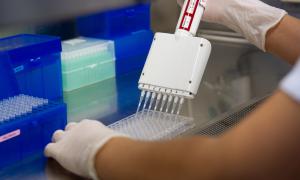A pioneering study identifies protective mechanisms in people with HIV resistant to disease progression

The scientific team has identified, in this group of individuals, the CCR5Δ32 genetic mutation, known to protect against HIV. Furthermore, they observed an atypical immune response, characterized by reduced activation and low levels of markers associated with intestinal mucosal alterations
IrsiCaixa, in collaboration with the National Center for Genomic Analysis (CNAG) and the Wistar Institute in Philadelphia, has characterized one of the most important cohorts of viremic nonprogressors (VNPs) using new high-throughput exploration techniques. This phenotype is very rare among people living with HIV –representing only 0.1%– and, despite viral replication, they have the ability to maintain stable levels of immune cells. The study compared various viral, genetic, and metabolic factors of 16 VNPs with those of 29 people with HIV who exhibit standard progression of the viral infection. Published in the Med journal by Cell Press, the study reveals crucial mechanisms of immune protection in VNPs. Among these, the presence of the genetic mutation CCR5Δ32 stands out, located in one of the two copies of the gene in the human genome, which confers resistance to HIV, as well as a more regulated and balanced immune response.
"The characteristics identified in this comprehensive analysis could be fundamental for improving current therapies and helping to restore immune balance in individuals who do not fully recover immune cell levels despite treatment", explains Mª Carmen Puertas, co-leader of the study and senior researcher at IrsiCaixa.
A rare phenotype that could revolutionize HIV therapies
The viremic nonprogressors individuals (VNPs) are characterized by maintaining a stable amount of CD4+ T lymphocytes, which are essential for keeping the immune system balanced. This distinctive feature allows them to resist progression to stages of immune deterioration typically caused by untreated HIV. One of the key factors contributing to this resistance is the frequent presence of the CCR5Δ32 mutation. “We have identified that many VNPs are carriers of this mutation in a heterozygous state, meaning they have it in one of the two copies of the gene present in the genome. This mutation leads to lower levels of the CCR5 receptor in the target cells of the infection, which is one of the entry points the virus uses to infect cells. Without this access point, HIV cannot infect as many cells, and the infection is more contained”, points out Ángel Bayón, first author of the article and predoctoral researcher at IrsiCaixa during the study.
Furthermore, VNPs exhibit a more moderate immune activation and an attenuated interferon response, which protects them from chronic inflammation, a common problem in people with HIV. This immune modulation seems to be closely related to the health of the intestines, which often shows a decrease in mucosal integrity in people with HIV, further enhancing chronic immune activation. "Lower levels of zonulin, a marker of intestinal permeability, indicate that this barrier is better preserved in VNPs. This intestinal stability could be a key piece in their ability to slow down disease progression”, explains Javier Martínez-Picado, co-leader of the study and ICREA researcher at IrsiCaixa.
Similarities with natural hosts of SIV
Interestingly, VNPs exhibit a profile similar to that of the natural hosts of SIV, the simian immunodeficiency virus that affects primates such as the African green monkey or the sooty mangabey. Infection in these animals does not cause disease, a fact attributed to an adaptation between the virus and the host over thousands of years, as well as co-evolution. “Thus, we see that VNPs may share immune characteristics with the natural hosts of SIV. Studying them could therefore reveal key mechanisms of tolerance to infection and shed new light on the interaction between virus and host”, suggests Martínez-Picado.
This study, one of the most extensive conducted on the VNP phenotype, represents a significant advancement in the research of new therapeutic interventions. "The extensive knowledge generated in this work will help us develop new therapeutic strategies for people living with HIV who experience incomplete immune recovery", concludes Puertas.